ACCG224: Accounting Financial Analysis Report on Blackmores 2019
VerifiedAdded on 2022/12/15
|10
|1999
|177
Report
AI Summary
This report presents a financial analysis of Blackmores' annual report for the year ended June 30, 2018, focusing on the application of professional judgment in accounting, particularly concerning impairment testing. The report investigates the role of professional judgment, disclosures made by Blackmores for impairment of assets, and the valuation methods used, including the determination of the discount rate for cash flow analysis. The analysis reveals that while Blackmores generally complies with AASB standards in estimating cash flows, the use of a post-tax discount rate deviates from the standard's requirement for a pre-tax rate. The report concludes with recommendations for improved adherence to AASB standards, specifically regarding the discount rate and the provision of detailed breakdowns of impairment losses. The analysis covers key aspects such as recoverable amount, value in use (VIU), cash generating units (CGU), and the fundamental characteristics of financial reporting, including relevance and faithful representation.
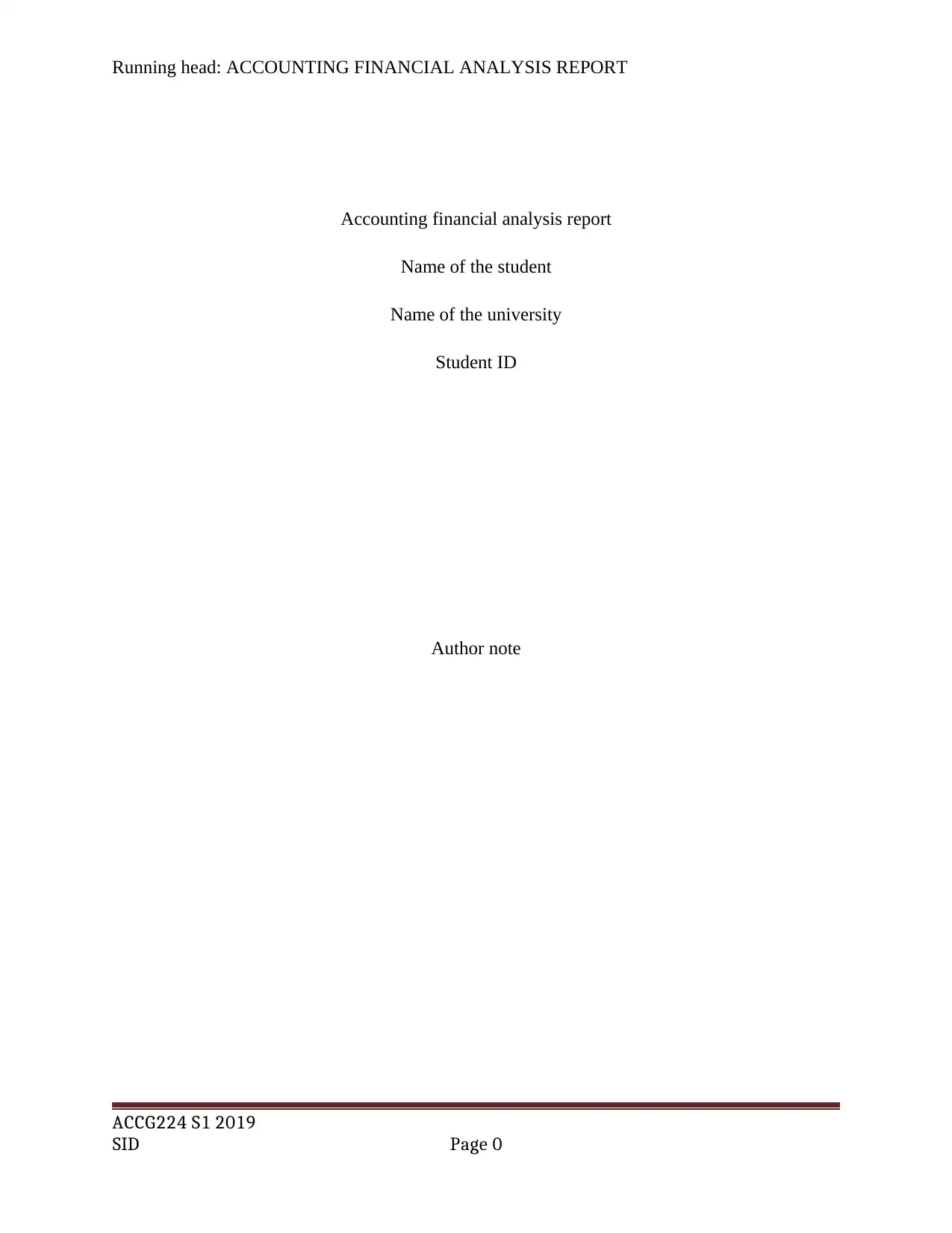
Running head: ACCOUNTING FINANCIAL ANALYSIS REPORT
Accounting financial analysis report
Name of the student
Name of the university
Student ID
Author note
ACCG224 S1 2019
SID Page 0
Accounting financial analysis report
Name of the student
Name of the university
Student ID
Author note
ACCG224 S1 2019
SID Page 0
Paraphrase This Document
Need a fresh take? Get an instant paraphrase of this document with our AI Paraphraser
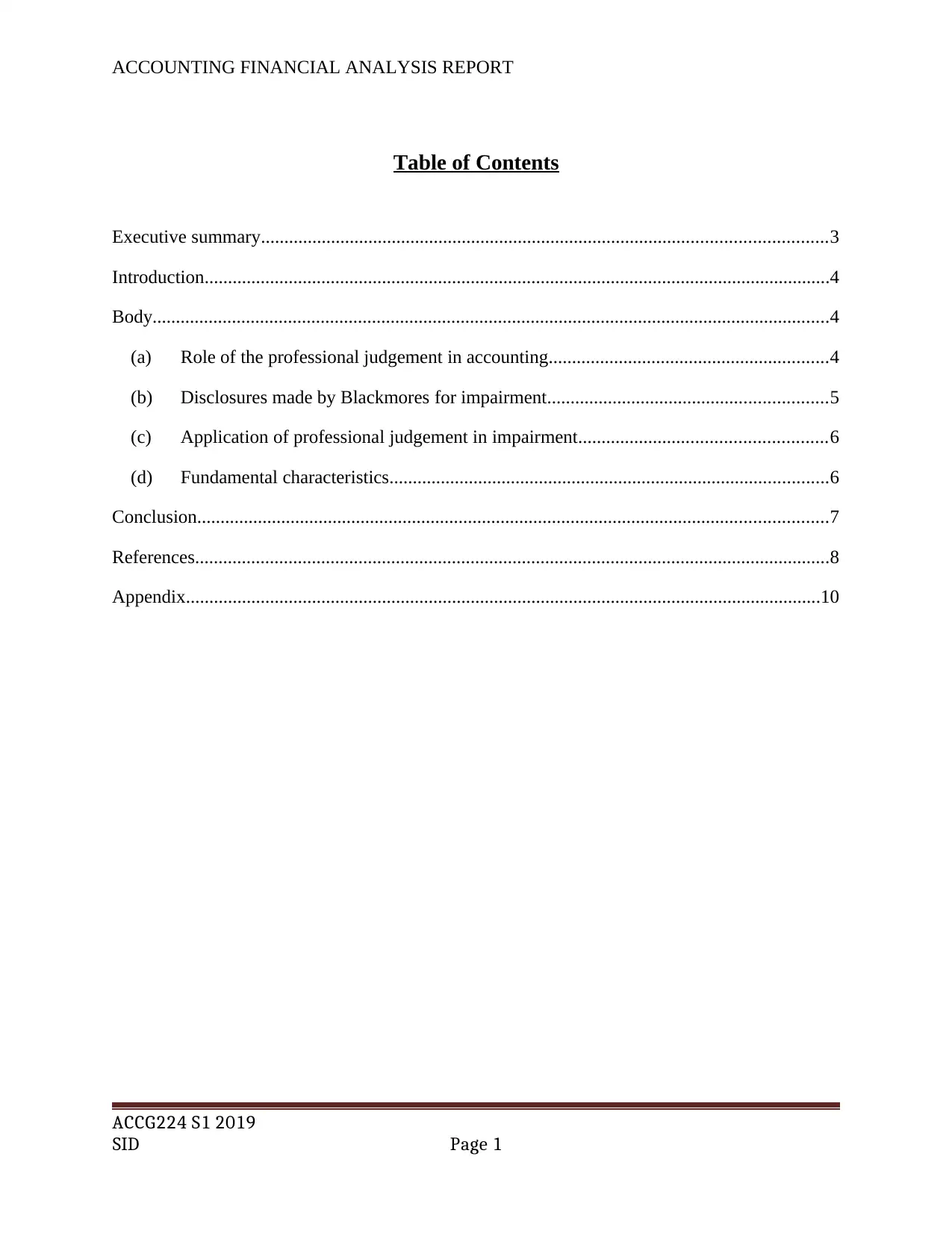
ACCOUNTING FINANCIAL ANALYSIS REPORT
Table of Contents
Executive summary.........................................................................................................................3
Introduction......................................................................................................................................4
Body.................................................................................................................................................4
(a) Role of the professional judgement in accounting............................................................4
(b) Disclosures made by Blackmores for impairment............................................................5
(c) Application of professional judgement in impairment.....................................................6
(d) Fundamental characteristics..............................................................................................6
Conclusion.......................................................................................................................................7
References........................................................................................................................................8
Appendix........................................................................................................................................10
ACCG224 S1 2019
SID Page 1
Table of Contents
Executive summary.........................................................................................................................3
Introduction......................................................................................................................................4
Body.................................................................................................................................................4
(a) Role of the professional judgement in accounting............................................................4
(b) Disclosures made by Blackmores for impairment............................................................5
(c) Application of professional judgement in impairment.....................................................6
(d) Fundamental characteristics..............................................................................................6
Conclusion.......................................................................................................................................7
References........................................................................................................................................8
Appendix........................................................................................................................................10
ACCG224 S1 2019
SID Page 1
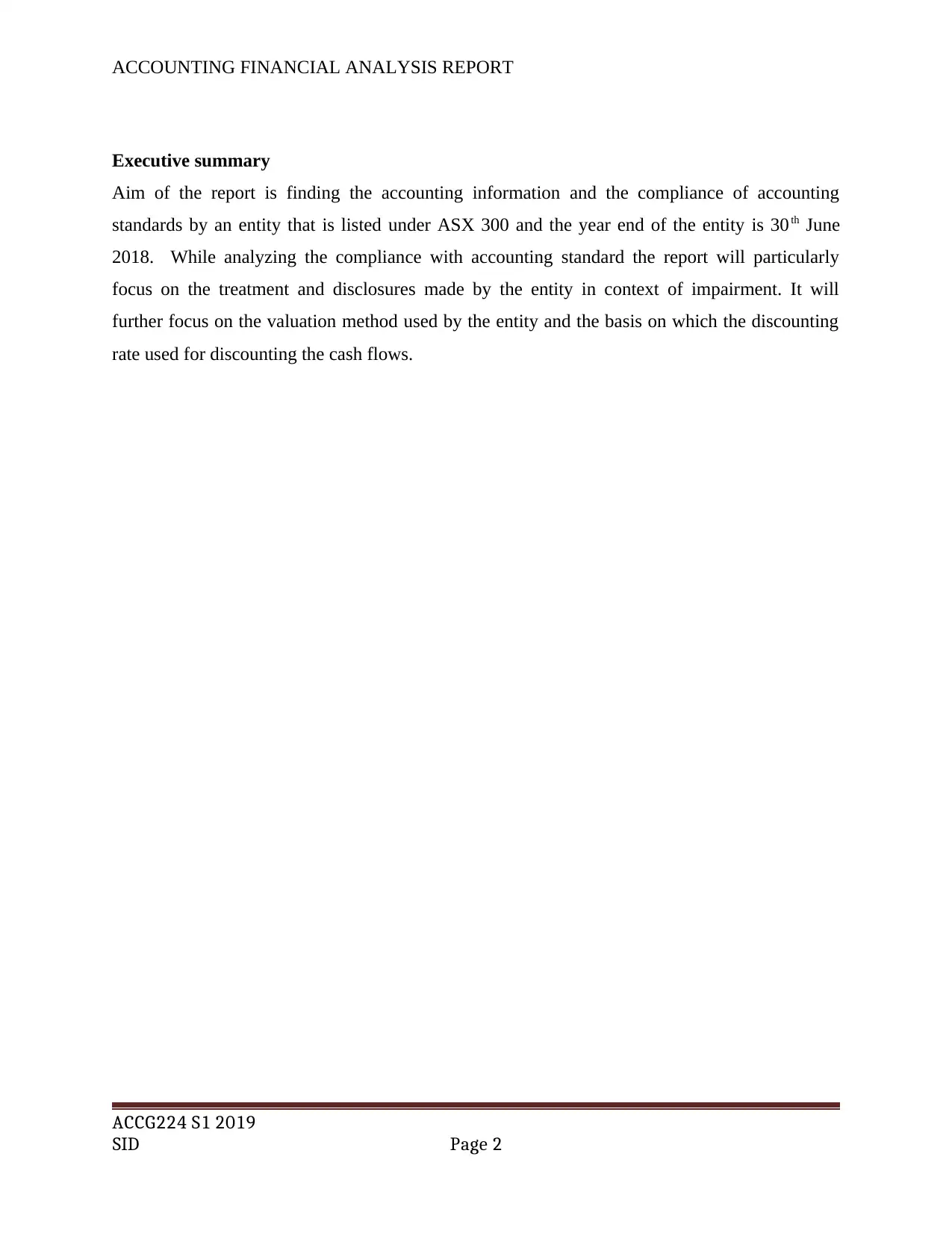
ACCOUNTING FINANCIAL ANALYSIS REPORT
Executive summary
Aim of the report is finding the accounting information and the compliance of accounting
standards by an entity that is listed under ASX 300 and the year end of the entity is 30th June
2018. While analyzing the compliance with accounting standard the report will particularly
focus on the treatment and disclosures made by the entity in context of impairment. It will
further focus on the valuation method used by the entity and the basis on which the discounting
rate used for discounting the cash flows.
ACCG224 S1 2019
SID Page 2
Executive summary
Aim of the report is finding the accounting information and the compliance of accounting
standards by an entity that is listed under ASX 300 and the year end of the entity is 30th June
2018. While analyzing the compliance with accounting standard the report will particularly
focus on the treatment and disclosures made by the entity in context of impairment. It will
further focus on the valuation method used by the entity and the basis on which the discounting
rate used for discounting the cash flows.
ACCG224 S1 2019
SID Page 2
⊘ This is a preview!⊘
Do you want full access?
Subscribe today to unlock all pages.

Trusted by 1+ million students worldwide
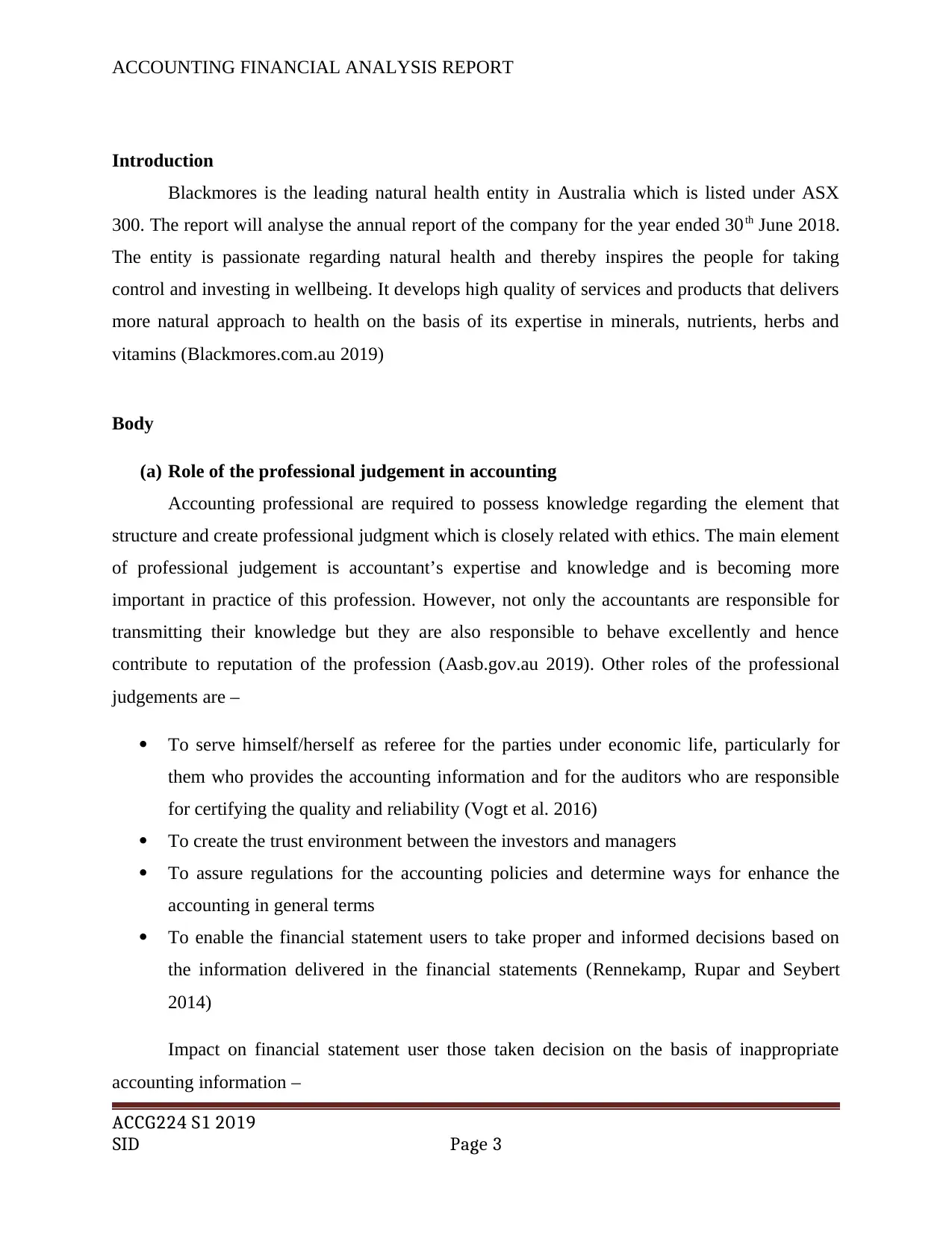
ACCOUNTING FINANCIAL ANALYSIS REPORT
Introduction
Blackmores is the leading natural health entity in Australia which is listed under ASX
300. The report will analyse the annual report of the company for the year ended 30th June 2018.
The entity is passionate regarding natural health and thereby inspires the people for taking
control and investing in wellbeing. It develops high quality of services and products that delivers
more natural approach to health on the basis of its expertise in minerals, nutrients, herbs and
vitamins (Blackmores.com.au 2019)
Body
(a) Role of the professional judgement in accounting
Accounting professional are required to possess knowledge regarding the element that
structure and create professional judgment which is closely related with ethics. The main element
of professional judgement is accountant’s expertise and knowledge and is becoming more
important in practice of this profession. However, not only the accountants are responsible for
transmitting their knowledge but they are also responsible to behave excellently and hence
contribute to reputation of the profession (Aasb.gov.au 2019). Other roles of the professional
judgements are –
To serve himself/herself as referee for the parties under economic life, particularly for
them who provides the accounting information and for the auditors who are responsible
for certifying the quality and reliability (Vogt et al. 2016)
To create the trust environment between the investors and managers
To assure regulations for the accounting policies and determine ways for enhance the
accounting in general terms
To enable the financial statement users to take proper and informed decisions based on
the information delivered in the financial statements (Rennekamp, Rupar and Seybert
2014)
Impact on financial statement user those taken decision on the basis of inappropriate
accounting information –
ACCG224 S1 2019
SID Page 3
Introduction
Blackmores is the leading natural health entity in Australia which is listed under ASX
300. The report will analyse the annual report of the company for the year ended 30th June 2018.
The entity is passionate regarding natural health and thereby inspires the people for taking
control and investing in wellbeing. It develops high quality of services and products that delivers
more natural approach to health on the basis of its expertise in minerals, nutrients, herbs and
vitamins (Blackmores.com.au 2019)
Body
(a) Role of the professional judgement in accounting
Accounting professional are required to possess knowledge regarding the element that
structure and create professional judgment which is closely related with ethics. The main element
of professional judgement is accountant’s expertise and knowledge and is becoming more
important in practice of this profession. However, not only the accountants are responsible for
transmitting their knowledge but they are also responsible to behave excellently and hence
contribute to reputation of the profession (Aasb.gov.au 2019). Other roles of the professional
judgements are –
To serve himself/herself as referee for the parties under economic life, particularly for
them who provides the accounting information and for the auditors who are responsible
for certifying the quality and reliability (Vogt et al. 2016)
To create the trust environment between the investors and managers
To assure regulations for the accounting policies and determine ways for enhance the
accounting in general terms
To enable the financial statement users to take proper and informed decisions based on
the information delivered in the financial statements (Rennekamp, Rupar and Seybert
2014)
Impact on financial statement user those taken decision on the basis of inappropriate
accounting information –
ACCG224 S1 2019
SID Page 3
Paraphrase This Document
Need a fresh take? Get an instant paraphrase of this document with our AI Paraphraser
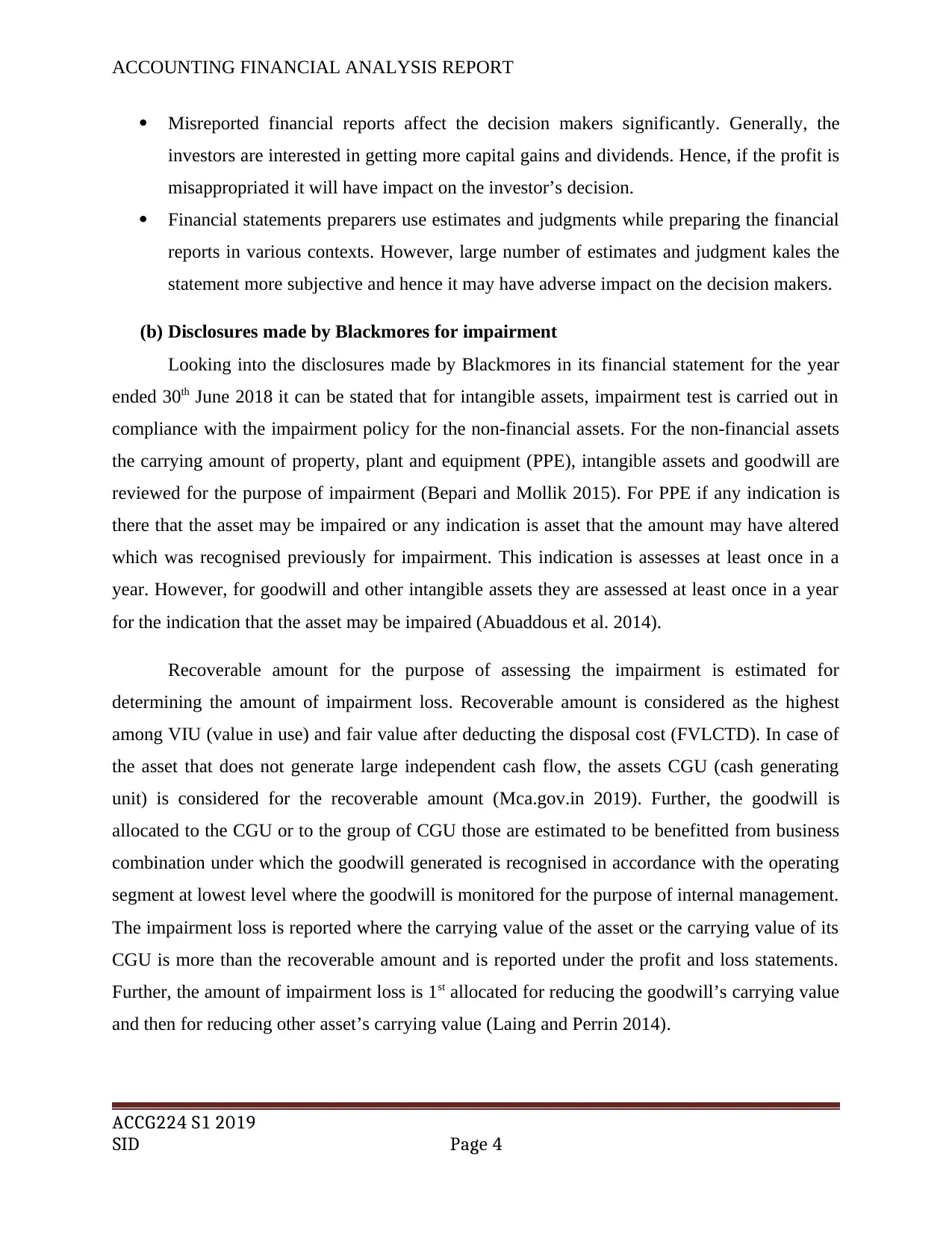
ACCOUNTING FINANCIAL ANALYSIS REPORT
Misreported financial reports affect the decision makers significantly. Generally, the
investors are interested in getting more capital gains and dividends. Hence, if the profit is
misappropriated it will have impact on the investor’s decision.
Financial statements preparers use estimates and judgments while preparing the financial
reports in various contexts. However, large number of estimates and judgment kales the
statement more subjective and hence it may have adverse impact on the decision makers.
(b) Disclosures made by Blackmores for impairment
Looking into the disclosures made by Blackmores in its financial statement for the year
ended 30th June 2018 it can be stated that for intangible assets, impairment test is carried out in
compliance with the impairment policy for the non-financial assets. For the non-financial assets
the carrying amount of property, plant and equipment (PPE), intangible assets and goodwill are
reviewed for the purpose of impairment (Bepari and Mollik 2015). For PPE if any indication is
there that the asset may be impaired or any indication is asset that the amount may have altered
which was recognised previously for impairment. This indication is assesses at least once in a
year. However, for goodwill and other intangible assets they are assessed at least once in a year
for the indication that the asset may be impaired (Abuaddous et al. 2014).
Recoverable amount for the purpose of assessing the impairment is estimated for
determining the amount of impairment loss. Recoverable amount is considered as the highest
among VIU (value in use) and fair value after deducting the disposal cost (FVLCTD). In case of
the asset that does not generate large independent cash flow, the assets CGU (cash generating
unit) is considered for the recoverable amount (Mca.gov.in 2019). Further, the goodwill is
allocated to the CGU or to the group of CGU those are estimated to be benefitted from business
combination under which the goodwill generated is recognised in accordance with the operating
segment at lowest level where the goodwill is monitored for the purpose of internal management.
The impairment loss is reported where the carrying value of the asset or the carrying value of its
CGU is more than the recoverable amount and is reported under the profit and loss statements.
Further, the amount of impairment loss is 1st allocated for reducing the goodwill’s carrying value
and then for reducing other asset’s carrying value (Laing and Perrin 2014).
ACCG224 S1 2019
SID Page 4
Misreported financial reports affect the decision makers significantly. Generally, the
investors are interested in getting more capital gains and dividends. Hence, if the profit is
misappropriated it will have impact on the investor’s decision.
Financial statements preparers use estimates and judgments while preparing the financial
reports in various contexts. However, large number of estimates and judgment kales the
statement more subjective and hence it may have adverse impact on the decision makers.
(b) Disclosures made by Blackmores for impairment
Looking into the disclosures made by Blackmores in its financial statement for the year
ended 30th June 2018 it can be stated that for intangible assets, impairment test is carried out in
compliance with the impairment policy for the non-financial assets. For the non-financial assets
the carrying amount of property, plant and equipment (PPE), intangible assets and goodwill are
reviewed for the purpose of impairment (Bepari and Mollik 2015). For PPE if any indication is
there that the asset may be impaired or any indication is asset that the amount may have altered
which was recognised previously for impairment. This indication is assesses at least once in a
year. However, for goodwill and other intangible assets they are assessed at least once in a year
for the indication that the asset may be impaired (Abuaddous et al. 2014).
Recoverable amount for the purpose of assessing the impairment is estimated for
determining the amount of impairment loss. Recoverable amount is considered as the highest
among VIU (value in use) and fair value after deducting the disposal cost (FVLCTD). In case of
the asset that does not generate large independent cash flow, the assets CGU (cash generating
unit) is considered for the recoverable amount (Mca.gov.in 2019). Further, the goodwill is
allocated to the CGU or to the group of CGU those are estimated to be benefitted from business
combination under which the goodwill generated is recognised in accordance with the operating
segment at lowest level where the goodwill is monitored for the purpose of internal management.
The impairment loss is reported where the carrying value of the asset or the carrying value of its
CGU is more than the recoverable amount and is reported under the profit and loss statements.
Further, the amount of impairment loss is 1st allocated for reducing the goodwill’s carrying value
and then for reducing other asset’s carrying value (Laing and Perrin 2014).
ACCG224 S1 2019
SID Page 4
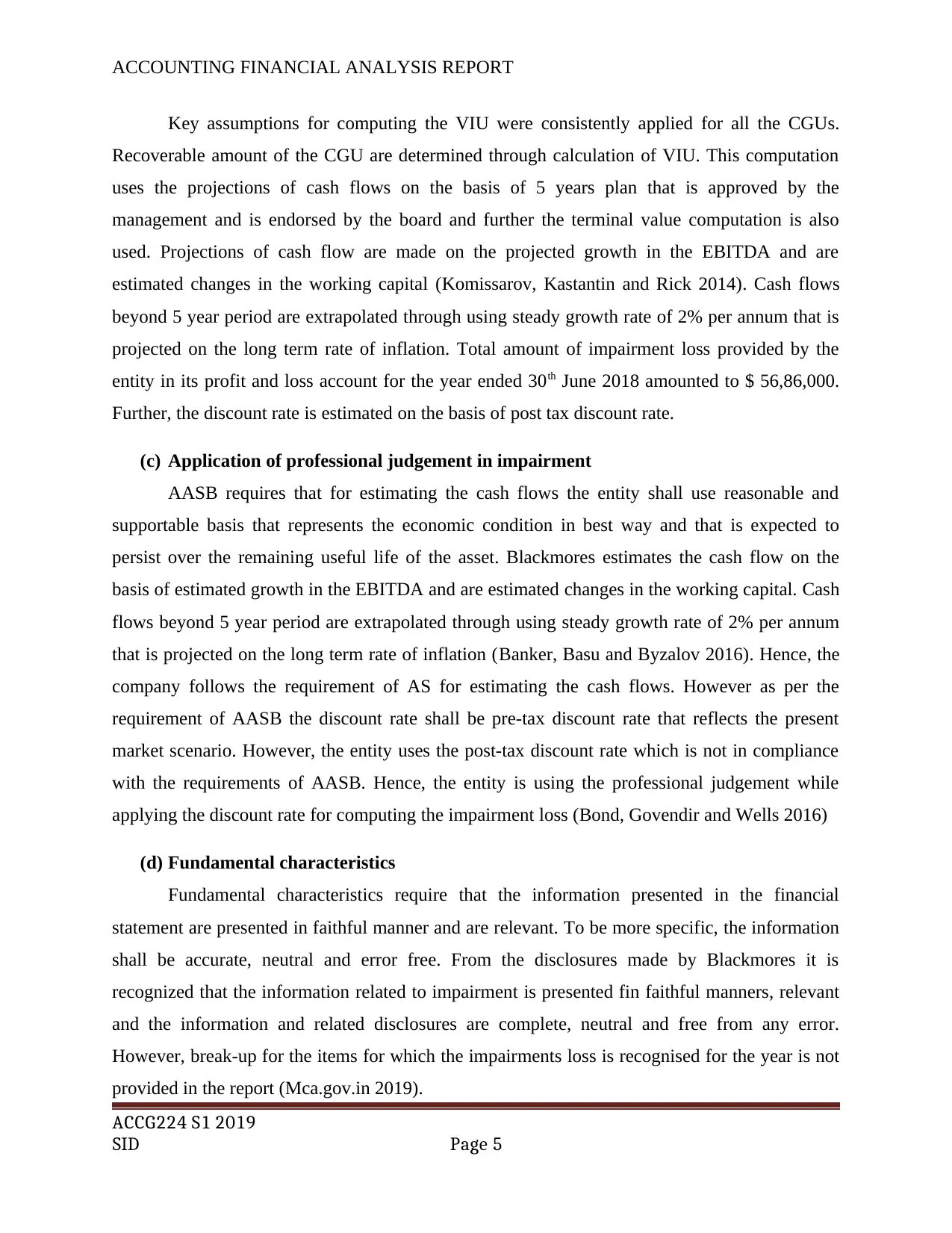
ACCOUNTING FINANCIAL ANALYSIS REPORT
Key assumptions for computing the VIU were consistently applied for all the CGUs.
Recoverable amount of the CGU are determined through calculation of VIU. This computation
uses the projections of cash flows on the basis of 5 years plan that is approved by the
management and is endorsed by the board and further the terminal value computation is also
used. Projections of cash flow are made on the projected growth in the EBITDA and are
estimated changes in the working capital (Komissarov, Kastantin and Rick 2014). Cash flows
beyond 5 year period are extrapolated through using steady growth rate of 2% per annum that is
projected on the long term rate of inflation. Total amount of impairment loss provided by the
entity in its profit and loss account for the year ended 30th June 2018 amounted to $ 56,86,000.
Further, the discount rate is estimated on the basis of post tax discount rate.
(c) Application of professional judgement in impairment
AASB requires that for estimating the cash flows the entity shall use reasonable and
supportable basis that represents the economic condition in best way and that is expected to
persist over the remaining useful life of the asset. Blackmores estimates the cash flow on the
basis of estimated growth in the EBITDA and are estimated changes in the working capital. Cash
flows beyond 5 year period are extrapolated through using steady growth rate of 2% per annum
that is projected on the long term rate of inflation (Banker, Basu and Byzalov 2016). Hence, the
company follows the requirement of AS for estimating the cash flows. However as per the
requirement of AASB the discount rate shall be pre-tax discount rate that reflects the present
market scenario. However, the entity uses the post-tax discount rate which is not in compliance
with the requirements of AASB. Hence, the entity is using the professional judgement while
applying the discount rate for computing the impairment loss (Bond, Govendir and Wells 2016)
(d) Fundamental characteristics
Fundamental characteristics require that the information presented in the financial
statement are presented in faithful manner and are relevant. To be more specific, the information
shall be accurate, neutral and error free. From the disclosures made by Blackmores it is
recognized that the information related to impairment is presented fin faithful manners, relevant
and the information and related disclosures are complete, neutral and free from any error.
However, break-up for the items for which the impairments loss is recognised for the year is not
provided in the report (Mca.gov.in 2019).
ACCG224 S1 2019
SID Page 5
Key assumptions for computing the VIU were consistently applied for all the CGUs.
Recoverable amount of the CGU are determined through calculation of VIU. This computation
uses the projections of cash flows on the basis of 5 years plan that is approved by the
management and is endorsed by the board and further the terminal value computation is also
used. Projections of cash flow are made on the projected growth in the EBITDA and are
estimated changes in the working capital (Komissarov, Kastantin and Rick 2014). Cash flows
beyond 5 year period are extrapolated through using steady growth rate of 2% per annum that is
projected on the long term rate of inflation. Total amount of impairment loss provided by the
entity in its profit and loss account for the year ended 30th June 2018 amounted to $ 56,86,000.
Further, the discount rate is estimated on the basis of post tax discount rate.
(c) Application of professional judgement in impairment
AASB requires that for estimating the cash flows the entity shall use reasonable and
supportable basis that represents the economic condition in best way and that is expected to
persist over the remaining useful life of the asset. Blackmores estimates the cash flow on the
basis of estimated growth in the EBITDA and are estimated changes in the working capital. Cash
flows beyond 5 year period are extrapolated through using steady growth rate of 2% per annum
that is projected on the long term rate of inflation (Banker, Basu and Byzalov 2016). Hence, the
company follows the requirement of AS for estimating the cash flows. However as per the
requirement of AASB the discount rate shall be pre-tax discount rate that reflects the present
market scenario. However, the entity uses the post-tax discount rate which is not in compliance
with the requirements of AASB. Hence, the entity is using the professional judgement while
applying the discount rate for computing the impairment loss (Bond, Govendir and Wells 2016)
(d) Fundamental characteristics
Fundamental characteristics require that the information presented in the financial
statement are presented in faithful manner and are relevant. To be more specific, the information
shall be accurate, neutral and error free. From the disclosures made by Blackmores it is
recognized that the information related to impairment is presented fin faithful manners, relevant
and the information and related disclosures are complete, neutral and free from any error.
However, break-up for the items for which the impairments loss is recognised for the year is not
provided in the report (Mca.gov.in 2019).
ACCG224 S1 2019
SID Page 5
⊘ This is a preview!⊘
Do you want full access?
Subscribe today to unlock all pages.

Trusted by 1+ million students worldwide
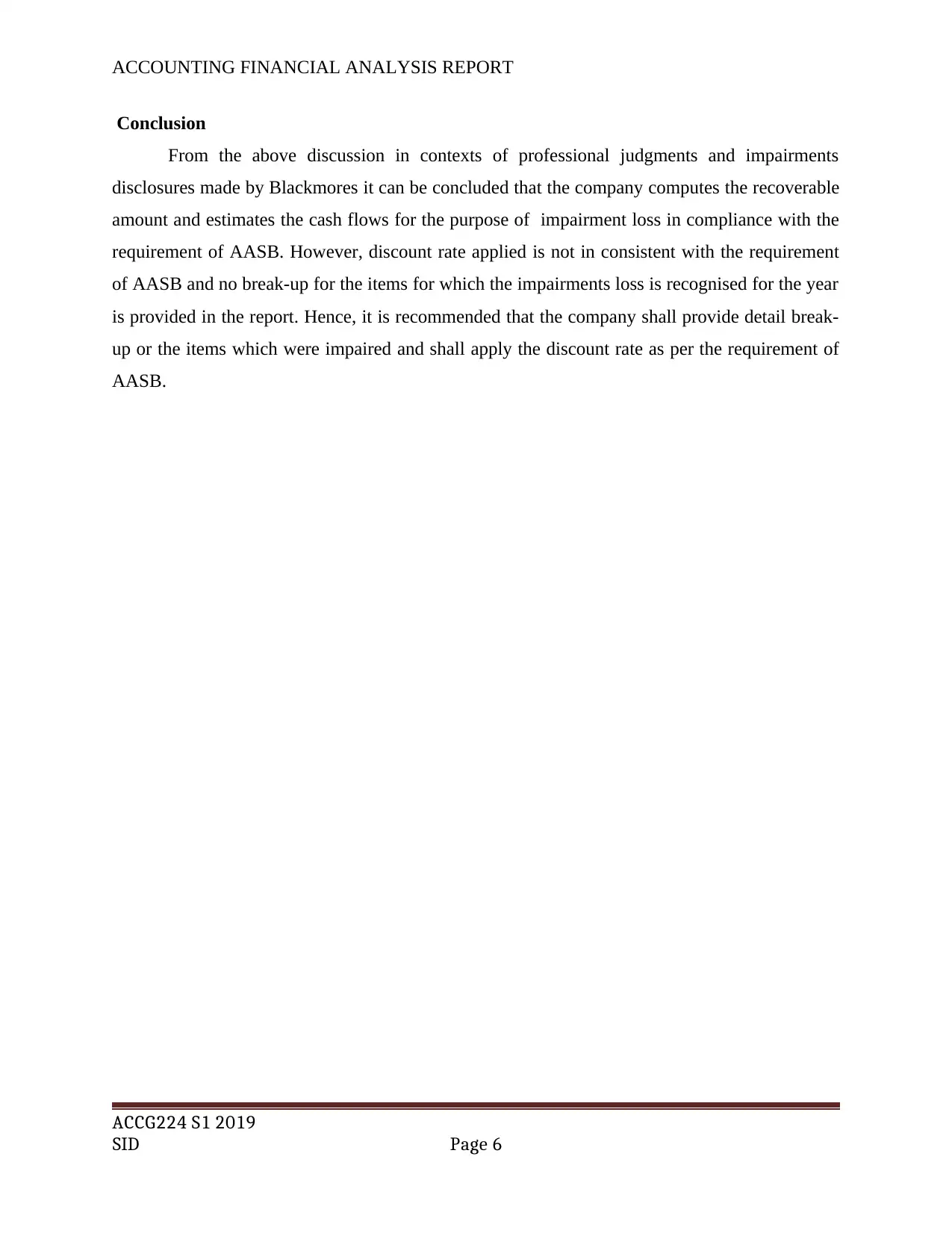
ACCOUNTING FINANCIAL ANALYSIS REPORT
Conclusion
From the above discussion in contexts of professional judgments and impairments
disclosures made by Blackmores it can be concluded that the company computes the recoverable
amount and estimates the cash flows for the purpose of impairment loss in compliance with the
requirement of AASB. However, discount rate applied is not in consistent with the requirement
of AASB and no break-up for the items for which the impairments loss is recognised for the year
is provided in the report. Hence, it is recommended that the company shall provide detail break-
up or the items which were impaired and shall apply the discount rate as per the requirement of
AASB.
ACCG224 S1 2019
SID Page 6
Conclusion
From the above discussion in contexts of professional judgments and impairments
disclosures made by Blackmores it can be concluded that the company computes the recoverable
amount and estimates the cash flows for the purpose of impairment loss in compliance with the
requirement of AASB. However, discount rate applied is not in consistent with the requirement
of AASB and no break-up for the items for which the impairments loss is recognised for the year
is provided in the report. Hence, it is recommended that the company shall provide detail break-
up or the items which were impaired and shall apply the discount rate as per the requirement of
AASB.
ACCG224 S1 2019
SID Page 6
Paraphrase This Document
Need a fresh take? Get an instant paraphrase of this document with our AI Paraphraser
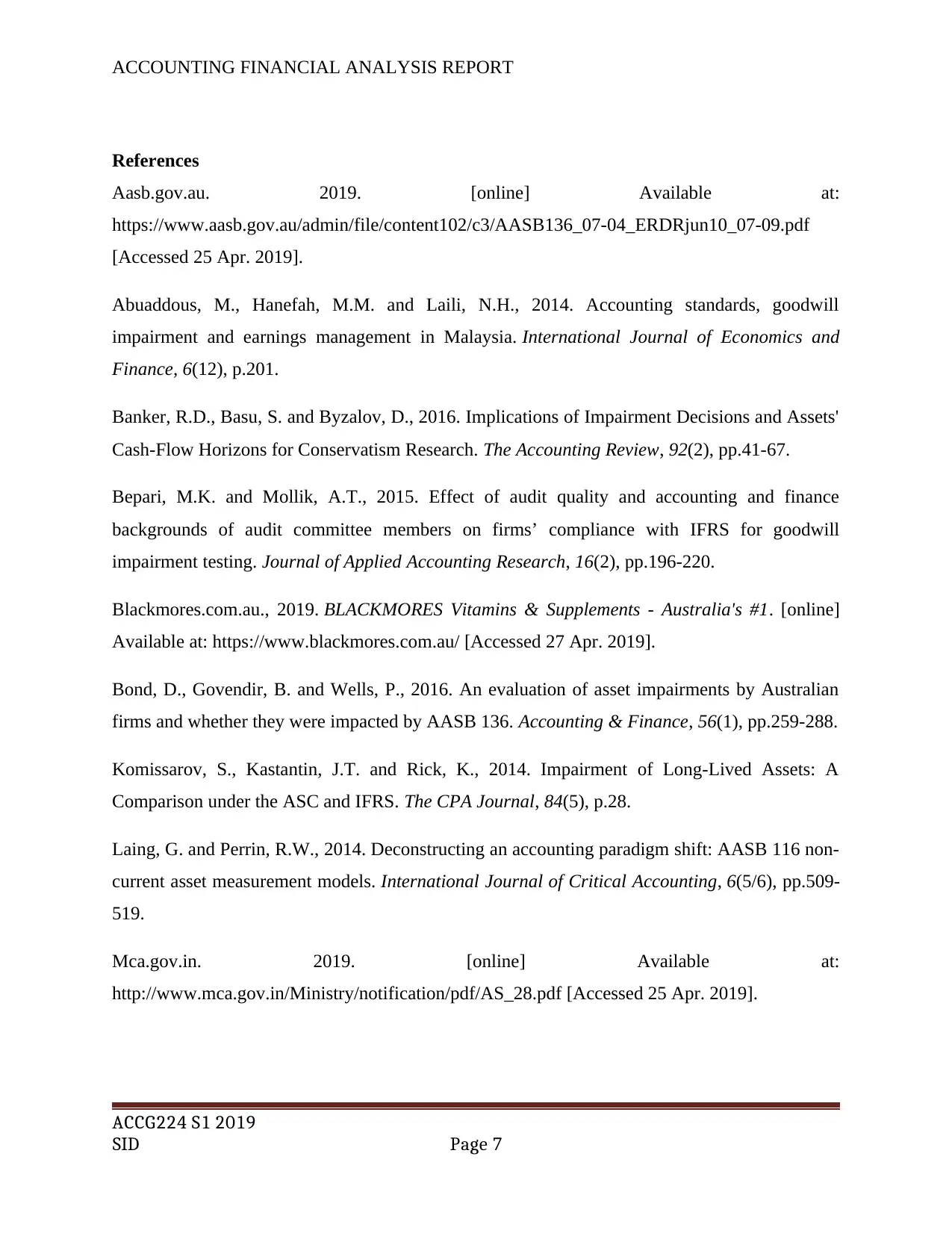
ACCOUNTING FINANCIAL ANALYSIS REPORT
References
Aasb.gov.au. 2019. [online] Available at:
https://www.aasb.gov.au/admin/file/content102/c3/AASB136_07-04_ERDRjun10_07-09.pdf
[Accessed 25 Apr. 2019].
Abuaddous, M., Hanefah, M.M. and Laili, N.H., 2014. Accounting standards, goodwill
impairment and earnings management in Malaysia. International Journal of Economics and
Finance, 6(12), p.201.
Banker, R.D., Basu, S. and Byzalov, D., 2016. Implications of Impairment Decisions and Assets'
Cash-Flow Horizons for Conservatism Research. The Accounting Review, 92(2), pp.41-67.
Bepari, M.K. and Mollik, A.T., 2015. Effect of audit quality and accounting and finance
backgrounds of audit committee members on firms’ compliance with IFRS for goodwill
impairment testing. Journal of Applied Accounting Research, 16(2), pp.196-220.
Blackmores.com.au., 2019. BLACKMORES Vitamins & Supplements - Australia's #1. [online]
Available at: https://www.blackmores.com.au/ [Accessed 27 Apr. 2019].
Bond, D., Govendir, B. and Wells, P., 2016. An evaluation of asset impairments by Australian
firms and whether they were impacted by AASB 136. Accounting & Finance, 56(1), pp.259-288.
Komissarov, S., Kastantin, J.T. and Rick, K., 2014. Impairment of Long-Lived Assets: A
Comparison under the ASC and IFRS. The CPA Journal, 84(5), p.28.
Laing, G. and Perrin, R.W., 2014. Deconstructing an accounting paradigm shift: AASB 116 non-
current asset measurement models. International Journal of Critical Accounting, 6(5/6), pp.509-
519.
Mca.gov.in. 2019. [online] Available at:
http://www.mca.gov.in/Ministry/notification/pdf/AS_28.pdf [Accessed 25 Apr. 2019].
ACCG224 S1 2019
SID Page 7
References
Aasb.gov.au. 2019. [online] Available at:
https://www.aasb.gov.au/admin/file/content102/c3/AASB136_07-04_ERDRjun10_07-09.pdf
[Accessed 25 Apr. 2019].
Abuaddous, M., Hanefah, M.M. and Laili, N.H., 2014. Accounting standards, goodwill
impairment and earnings management in Malaysia. International Journal of Economics and
Finance, 6(12), p.201.
Banker, R.D., Basu, S. and Byzalov, D., 2016. Implications of Impairment Decisions and Assets'
Cash-Flow Horizons for Conservatism Research. The Accounting Review, 92(2), pp.41-67.
Bepari, M.K. and Mollik, A.T., 2015. Effect of audit quality and accounting and finance
backgrounds of audit committee members on firms’ compliance with IFRS for goodwill
impairment testing. Journal of Applied Accounting Research, 16(2), pp.196-220.
Blackmores.com.au., 2019. BLACKMORES Vitamins & Supplements - Australia's #1. [online]
Available at: https://www.blackmores.com.au/ [Accessed 27 Apr. 2019].
Bond, D., Govendir, B. and Wells, P., 2016. An evaluation of asset impairments by Australian
firms and whether they were impacted by AASB 136. Accounting & Finance, 56(1), pp.259-288.
Komissarov, S., Kastantin, J.T. and Rick, K., 2014. Impairment of Long-Lived Assets: A
Comparison under the ASC and IFRS. The CPA Journal, 84(5), p.28.
Laing, G. and Perrin, R.W., 2014. Deconstructing an accounting paradigm shift: AASB 116 non-
current asset measurement models. International Journal of Critical Accounting, 6(5/6), pp.509-
519.
Mca.gov.in. 2019. [online] Available at:
http://www.mca.gov.in/Ministry/notification/pdf/AS_28.pdf [Accessed 25 Apr. 2019].
ACCG224 S1 2019
SID Page 7
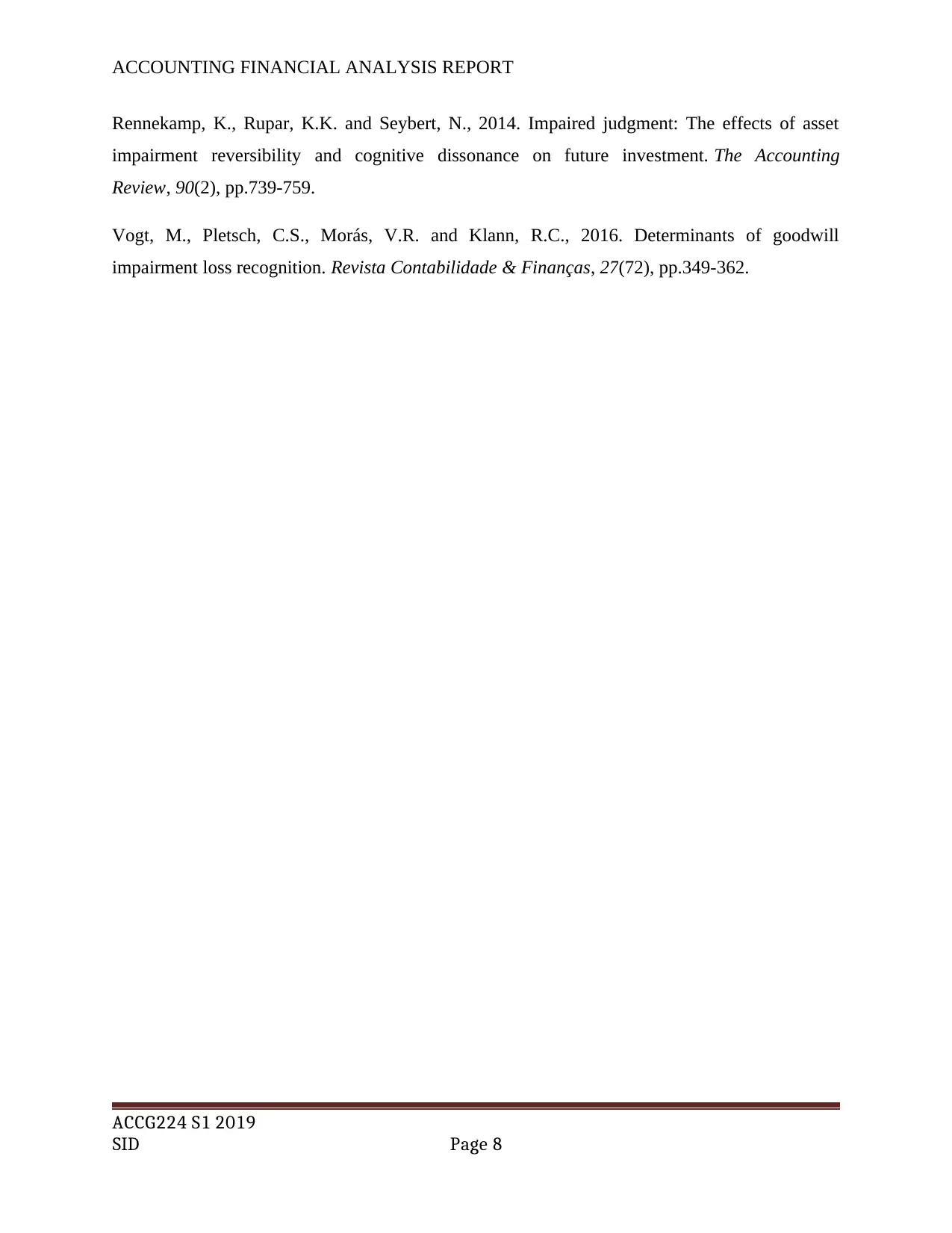
ACCOUNTING FINANCIAL ANALYSIS REPORT
Rennekamp, K., Rupar, K.K. and Seybert, N., 2014. Impaired judgment: The effects of asset
impairment reversibility and cognitive dissonance on future investment. The Accounting
Review, 90(2), pp.739-759.
Vogt, M., Pletsch, C.S., Morás, V.R. and Klann, R.C., 2016. Determinants of goodwill
impairment loss recognition. Revista Contabilidade & Finanças, 27(72), pp.349-362.
ACCG224 S1 2019
SID Page 8
Rennekamp, K., Rupar, K.K. and Seybert, N., 2014. Impaired judgment: The effects of asset
impairment reversibility and cognitive dissonance on future investment. The Accounting
Review, 90(2), pp.739-759.
Vogt, M., Pletsch, C.S., Morás, V.R. and Klann, R.C., 2016. Determinants of goodwill
impairment loss recognition. Revista Contabilidade & Finanças, 27(72), pp.349-362.
ACCG224 S1 2019
SID Page 8
⊘ This is a preview!⊘
Do you want full access?
Subscribe today to unlock all pages.

Trusted by 1+ million students worldwide
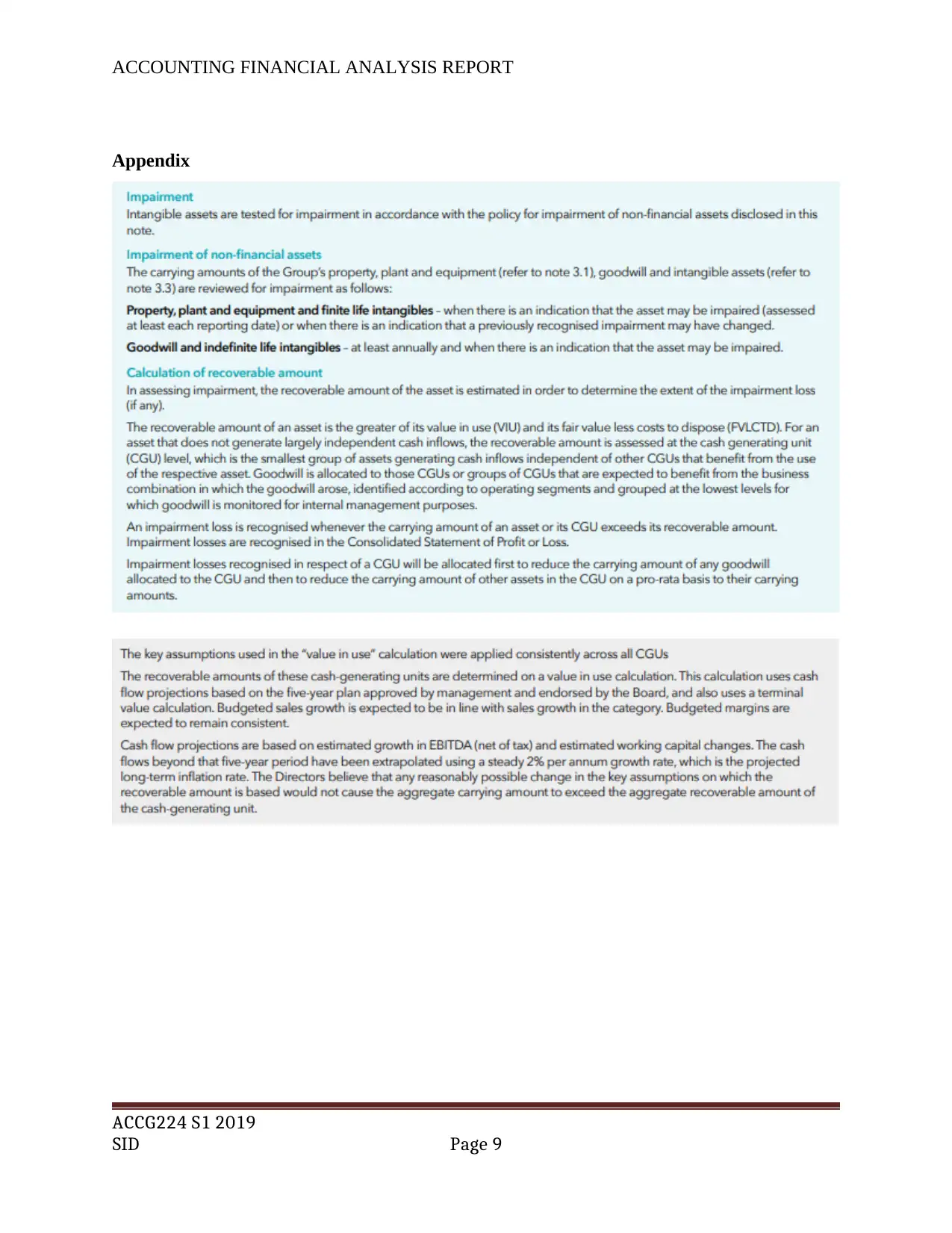
ACCOUNTING FINANCIAL ANALYSIS REPORT
Appendix
ACCG224 S1 2019
SID Page 9
Appendix
ACCG224 S1 2019
SID Page 9
1 out of 10
Related Documents
Your All-in-One AI-Powered Toolkit for Academic Success.
+13062052269
info@desklib.com
Available 24*7 on WhatsApp / Email
![[object Object]](/_next/static/media/star-bottom.7253800d.svg)
Unlock your academic potential
Copyright © 2020–2025 A2Z Services. All Rights Reserved. Developed and managed by ZUCOL.





